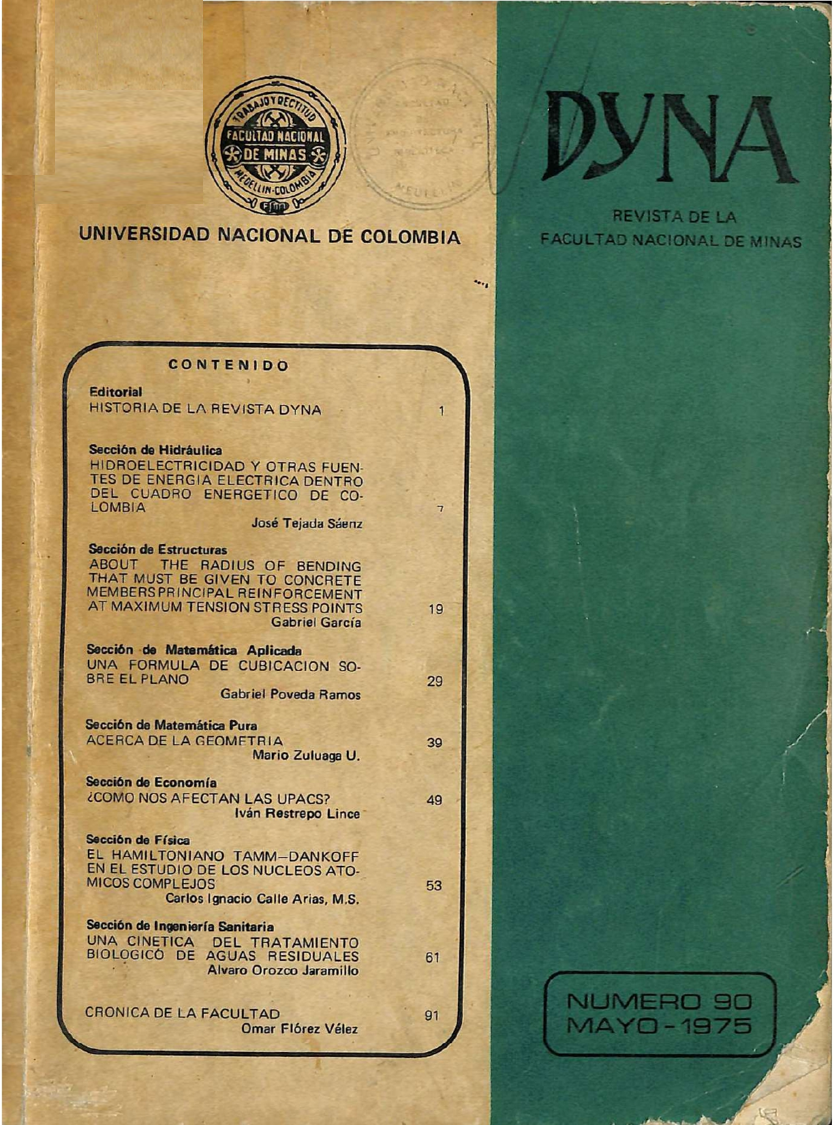About the radius of bending that must be given to concrete members principal reinforcement at maximun tension stress points
Palabras clave:
Ingeniería estructural, Análisis estructural, Estructuras, Diseño de estructuras, Esfuerzos y deformaciones, Resistencia de materiales, Hormigón armado (es)Descargas
Nota: El contenido de este artículo fue concebido como explicación de un grave accidente ocurrido por el diseño de una estructura de hormigón, hacia fines de 1970. Su destinatario era el American Concrete Institute, y esta es la razón fundamental de que haya sido escrito en inglés.
La reacción del A.C.I. no fue concluyente, pues al parecer exigían comprobación experimental del fenómeno. En la Facultad de Minas llevamos a cabo, en estos momentos, una investigación, financiada por Colciencias, que aunque no intenta corroborar la distribución de tensiones dada en la formula (9) del artículo, con inclusión de los fenómenos de fluencia y microfisuración, se relaciona íntimamente con aquel, pues tratamos de encontrar una forma racional de diseño de las piezas curvas, codos, etc., de hormigón armado, con resultados hasta la fecha muy alentadores.
Synopsis: A Method is developed to calculate the radius of bending of the principal reinforcing bars, at maximum tension stress points in curved members, corners of rigid frames, etc. A formula is found wich permits computation of lateral forces tending to split the concrete, caused by the curvature of the principal steel reinforcement. The solution is found by means of simple methods of static equilibrium, and hos been confirmed by other solutions using the "Theory of Elasticity". Some comparisons with the 318-63, and 318-71 and other rational norms and recommendation about stirrup utilization are made.
(Texto tomado de la fuente)
Referencias
(1) "Tratado del Hormigón Armado" (Treatise of Reinforced Concrete) art. 1.231 pag. 78. G. Franz. Editorial Gustavo Gili S.A. Barcelona. Spanish translation of "Konstrucktionslehre des Stahlbetons" Springer Verlag. Berlin.
(2) "Hormigón Pretensado" (Prestressed Concrete) Chap. 3 pag. 81 Leonhardt. Instituto Eduardo Torroja Madrid 1967. Spanish Translation of "Spannbeton für die Praxis". Wilhelm Ernst & Sohn, Berlin Munchen.
(3) A.C.I. 318-63 Chap 8-801, part c-2o., pag. 28.
(4) Theory of Elasticity" pag. 85. Timoshenko and Goodier, Mc-Graw Hill.
(5) "Resistence des Materiaux". R. L'Hermite pag. 97 (Strength of Materials) Dunod, Paris, I.T.B.T.P.
(6) "Proposed Revision of A.C.I. 318-63" Journal of the American Concrete Institute, February 1970.
(7) "Béton Précontraint" by Y. Guyon I.T.B.T.P. Eyrolloc Editeur Paris. 1958, pag. 205.
Cómo citar
IEEE
ACM
ACS
APA
ABNT
Chicago
Harvard
MLA
Turabian
Vancouver
Descargar cita
Visitas a la página del resumen del artículo
Descargas
Licencia
Derechos de autor 2024 DYNA

Esta obra está bajo una licencia internacional Creative Commons Atribución-NoComercial-SinDerivadas 4.0.
El autor o autores de un artículo aceptado para publicación en cualquiera de las revistas editadas por la facultad de Minas cederán la totalidad de los derechos patrimoniales a la Universidad Nacional de Colombia de manera gratuita, dentro de los cuáles se incluyen: el derecho a editar, publicar, reproducir y distribuir tanto en medios impresos como digitales, además de incluir en artículo en índices internacionales y/o bases de datos, de igual manera, se faculta a la editorial para utilizar las imágenes, tablas y/o cualquier material gráfico presentado en el artículo para el diseño de carátulas o posters de la misma revista.

















